Contents
- What organs are located in the lower abdomen in a man
- What organ can respond with pain?
- When the lower back and lower abdomen hurt in the center
- When the lower abdomen hurts on the left
- When the lower abdomen hurts
- When the lower abdomen hurts above the pubis
- Diagnosis based on the nature of the pain
- Diagnosis based on additional symptoms
- Necessary studies for diagnosis
- Treatment
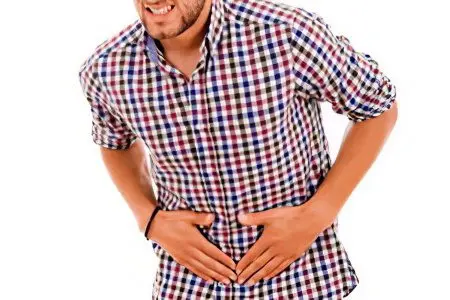
Pain is a symptom of trouble in the body. With this signal, he tries to communicate that some organ or organ system needs help. Therefore, pain cannot be ignored, it is necessary to find out its causes and eliminate them. Self-diagnosis can be dangerous, the doctor must deal with the detection and treatment of the disease.
Pain in the lower abdomen in a man is a very common occurrence. There can be many reasons for their occurrence. The article is intended to help understand them and orient a person to which specialist he needs to contact.
What organs are located in the lower abdomen in a man
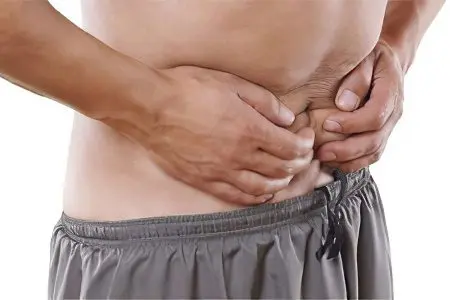
The lower part of the abdominal cavity is filled with various organs. Knowing their location, we can assume which organ gives pain signals.
Below the abdomen on the right side are the following organs:
Appendix;
Cecum;
The final section of the small intestine;
Lower part of the right ureter.
The following organs are located in the suprapubic region:
Small intestine;
The bladder and part of the ureters;
The prostate;
seminal vesicles.
Below the abdomen on the left side are the following organs:
Rectum;
Part of the small intestine;
Sigmoid colon;
Left ureter.
Pain in the lower abdomen does not always indicate the pathology of these organs. Sometimes pain can radiate from other body systems that border on them. This is possible thanks to an extensive network of nerve fibers that permeate the entire human body.
What organ can respond with pain?
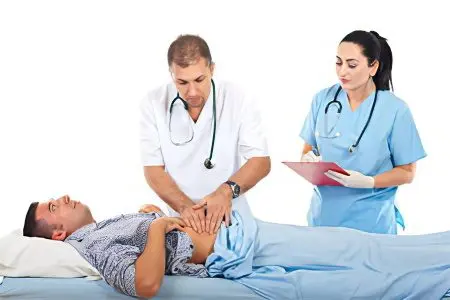
Pain in a man in the lower abdomen can occur with inflammation or tumor lesions of the following organs:
Stomach.
Any part of the intestine.
Appendix.
Bladder or ureter.
Prostate gland or testicles.
The lower sections of the spinal column.
seminal vesicles.
When the lower back and lower abdomen hurt in the center

Pain, concentrated in the center of the abdomen in its lower part, most often indicate certain disorders in the functioning of the organs of the urinary system, the prostate gland or the spinal column.
Renal colic. When the outflow of urine through the ureter is disturbed, a person develops renal colic. The ureter is a thin tube that runs from the kidney to the bladder. Passage disruption most often occurs due to obstruction of the ureter by stones. Nevertheless, it cannot be ruled out that its obstruction occurred against the background of an inflammatory process, or it was compressed by a tumor neoplasm. Moreover, the tumor is able to grow both from the organ itself and from the tissues that are in close proximity to the ureter.
Pain in renal colic has the following features:
The pain is paroxysmal.
Pain forces a person to constantly be in motion in order to find a position that will bring relief.
The pain radiates to the groin, to the genitals, to the pubis.
The general well-being of a person is disturbed, nausea may occur.
Body temperature may rise.
There may be blood in the urine.
Pathology of the kidneys. In a man, the left ureter or kidney may be affected if he has the following symptoms:
The pain is localized above the lumbar spine.
The volume of urine increased, or, on the contrary, became insignificant.
Body temperature has risen.
In the urine there are impurities of blood, pus, mucus.
Urine smells extremely bad.
Pathology of the spinal column. Pain in the lower abdomen and in the back area manifests many pathologies of the spine: osteochondrosis, Bechterew’s disease, spondylosis, etc.
In this case, the person will experience the following symptoms:
The pain does not migrate, it is localized in one area.
The pain is not diffuse, has a clear localization.
Pain shoots up my leg.
The chair is not broken, there are no signs of poisoning, such as nausea and vomiting.
In the morning, the pain hinders movement, and during the day it fades.
The lower limb on the one hand may lose sensitivity, sometimes there is a feeling that “goosebumps” are running along it.
When the lower abdomen hurts on the left
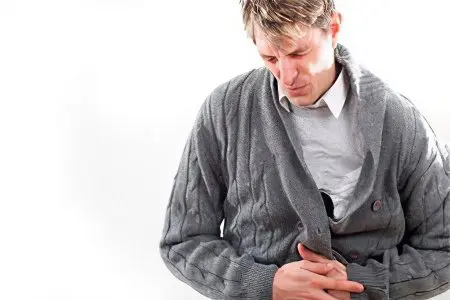
Causes of pain in the lower abdomen on the left side can be as follows:
Inflammation of the mucous membrane of the stomach and duodenum. If a man has exacerbated gastritis or gastroduodenitis, this will definitely be reflected in abdominal pain. They are localized in the epigastric region, radiating to the left side. It is difficult to suspect gastroduodenitis on your own, you need to seek help from a specialist. Symptoms that may suggest inflammation of the digestive organs: heartburn, nausea, pain when pressing on the center of the abdomen in its upper part.
Enlargement of the spleen in size. If the spleen increases in size, it will definitely manifest itself as pain in the left side in the lower abdomen, since the organ is located under the ribs on the left. Its expansion can occur against the background of inflammation of the organ, or with spasm of the venous vessels.
Other symptoms that help to suspect an acute enlargement of the spleen in size: high body temperature, vomiting, pain in the lower abdomen on the left side.
Spleen infarction. If the flow of arterial blood to the spleen is disturbed, then an organ infarction occurs. This is expressed by sharp pains that shoot from the left hypochondrium to the lower abdomen. When you try to take a deep breath, cough or move, the pain intensifies. Body temperature rises.
Abscess of the spleen. An abscess is a purulent lesion of an organ. It develops when pathogenic bacteria enter it. They are able to penetrate the spleen through the systemic circulation.
Symptoms of an organ abscess are:
Pain in the left hypochondrium. It extends to the chest and lower abdomen.
Body temperature rises.
Feelings are deteriorating rapidly.
Weakness and nausea join.
Bend of the spleen. This condition is characterized by volvulus of the artery that feeds the organ. The cause may be a congenital anomaly of the mesenteric ligaments, or an injury to the spleen. The following symptoms indicate the volvulus of the artery: constipation and increased gas formation, vomiting, and impaired health. The pain originates in the region of the left hypochondrium and descends to the lower abdomen.
Lymphocytic leukemia or chronic myelogenous leukemia. Pain in these forms of blood cancer appears in the lower abdomen after eating. It can be felt on palpation of the area. As the disease progresses, the pain gets worse.
Crohn’s disease. This disease is characterized by intestinal damage, it is manifested by the following symptoms:
Pain that migrates throughout the abdominal cavity.
Diarrhea and vomiting.
Increased fatigue.
Arthralgia.
Lack of desire to eat.
These symptoms are especially pronounced at a time when the disease is exacerbated. During remission, the main symptoms do not bother the person.
Polyposis. Frequent inflammation of the intestine leads to the formation of polyps on its wall. These neoplasms are permeated with nerves, therefore, they can manifest themselves as painful sensations when food masses pass through the intestines. Polyps must be removed, as they are capable of malignancy.
Nonspecific ulcerative colitis (NSA). With NUC, the large intestine suffers, which is covered with ulcers from the inside. The reasons for the development of pathology have not been established to date.
Symptoms of this form of colitis:
High body temperature.
In the early stages of the development of the disease, pain is localized precisely on the left side of the abdomen, in its lower part.
Bloating.
Violation of well-being.
Unstable chair.
Diverticulitis. With diverticulitis, the intestinal walls are covered with protrusions resembling small hernias. Diverticulitis affects older people. Sometimes the disease does not manifest itself in any way and it can only be detected when an x-ray is performed using a contrast agent, and the study can be performed for a completely different reason.
Appendicitis, with an atypical location of the appendix. Appendicitis always manifests with pain in the upper abdomen, which then moves to the right side. However, when the process is located in an atypical place for it, pain can be given precisely to the left side. As the inflammation increases, the pain increases. The nature of the pain is pulsating, cramping. In parallel, nausea and vomiting can be observed, sometimes diarrhea develops. Body temperature is usually elevated.
With inflammation of the diverticula, abdominal pain is observed, constipation develops, and body temperature rises.
When the lower abdomen hurts
If the pain is concentrated in the right lower abdomen, then the following pathologies can be suspected:
Diverticulitis.
Inflammation of the right kidney or ureter.
Appendicitis.
Crohn’s disease.
Diseases of the spinal column.
When the lower abdomen hurts above the pubis
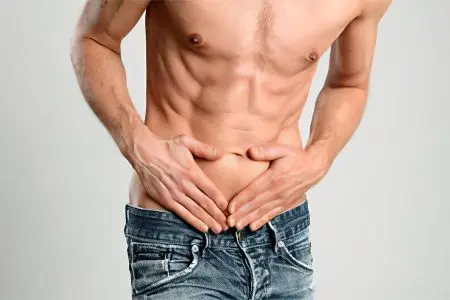
Pain, concentrated in the lower abdomen directly above the pubis, can characterize the following disorders in the body:
Prostatitis in the acute phase. With an exacerbation of prostatitis, the pain is sharp, stabbing, covers the entire perineum, radiates to the testicles and groin, to the rectum and sacrum. If the prostatitis is not exacerbated for the first time, then the pain becomes pulling. The cause of exacerbation of inflammation can be alcohol abuse, staying in the cold, overwork.
Cystitis. With inflammation of the bladder, a man experiences the following symptoms:
Pain during emptying of the bladder, which does not empty it completely.
Increased urge to urinate.
The appearance of blood impurities in the urine.
Urine becomes cloudy.
The pain in the pubic area becomes a pulling character.
Body temperature rises.
If the disease is severe, vomiting and nausea may occur.
Bladder cancer. When the tumor reaches an impressive size, it begins to cause difficulty emptying the bladder. Blood impurities appear in the urine. Further progression of the disease resembles the symptoms of cystitis, lumbar pains, pains above the pubis join, and it is not possible to eliminate them by taking antispasmodics. Body temperature in bladder cancer rarely rises.
BPH. Urination becomes more frequent, the man begins to wake up at night to empty his bladder. The prostate increases in size, which leads to the fact that a man begins to experience pain during urination. Feelings are sharp, stabbing. In addition to urinary retention, there is pain in the lower back.
Prostate cancer. When the neoplasm grows, the first symptoms of the disease appear:
Pain in the perineum.
Increased urge to urinate.
Blood appears in urine and semen.
The stream of urine loses its former pressure.
When the tumor begins to spread metastases, the person will lose weight, he will lose his appetite. There are pains in the chest, weakness does not recede even after a good rest. With the defeat of the skeleton, there are pains in the joints and bones.
Vesiculitis. Inflammation of the seminal vesicles is manifested by the following symptoms:
In addition to pain, a man begins to worry about urination disorders. During emptying of the bladder, there will be sharp pains in the abdomen, urges become frequent. Possible urinary retention. In addition, erection suffers.
The pain spreads to the sacrum, becomes stronger during bowel movements, or when the bladder is full.
Pain always accompanies erection and ejaculation.
Blood impurities appear in the semen.
Urination is disturbed.
General well-being is disturbed.
Diagnosis based on the nature of the pain
The pain is dull. |
|
The pain is sharp. |
|
The pain proceeds according to the type of contractions. |
|
The pain is sharp. |
|
The pain is aching. |
|
Pulling pain. |
|
The pain is cutting. |
|
The pain is very intense. |
|
Diagnosis based on additional symptoms

To determine the cause of pain, it is not enough just to know the symptoms, you should start from what exactly accompanied its onset.
Pain and connection with certain events. If pain occurs immediately after emptying the bladder, then this may indicate inflammation of the bladder.
If a man was in the cold for a long time before the onset of pain, then his prostatitis or cystitis could worsen.
If pain occurs after intimacy, then it may signal vesiculitis or prostatitis.
If the pain manifests itself after eating, then it may be a symptom of irritable bowel. In addition, with nervous tension, a man will feel the urge to empty his intestines, and after going to the toilet, there is a feeling that the act of defecation is not fully completed. This syndrome is also characterized by alternating constipation and diarrhea.
High body temperature. If, against the background of pain in the lower abdomen, the body temperature rises, then this may be a sign of the following pathologies:
Infectious inflammation of the seminal vesicles.
Acute inflammation of the prostate.
Diverticulitis.
Kidney inflammation.
Urolithiasis that provoked renal colic.
Inflammation of the appendix.
Severe course of cystitis.
Crohn’s disease.
Pathology of the spleen.
Pain on palpation. If a man experiences pain in the lower abdomen during palpation of the peritoneum, this may indicate the following pathologies:
Inflammation of the appendix.
Intestinal abscess.
Spleen infarction.
Diverticulitis.
Necessary studies for diagnosis

To determine the true cause of pain in a man, which is localized in the lower abdomen, he will need to visit a doctor. It can be a gastroenterologist or a urologist.
During the initial visit, you will need to go through the following procedures:
Answer the doctor’s questions about how long the man has been experiencing pain, and whether it is related to other situations. The doctor will be interested in how intense the pain is, what is its nature, where exactly it is concentrated.
After the interview, the doctor will begin to palpate the abdominal wall. You may need to palpate the prostate, which is performed through the rectum.
If necessary, the specialist will give the patient a referral for the following diagnostic procedures:
Ultrasound of the organs located in the abdominal cavity.
Ultrasound of the prostate.
Contrast x-ray examination of the intestine.
Ultrasound of the pancreas.
Ultrasound of the urinary system.
If a tumor is found, tissue sampling will be required. A biopsy is most often performed during surgery, when after excision of the tumor, a small part of it is separated and sent for histological analysis. Before referring the patient for surgery, a number of preparatory measures are carried out, including MRI or CT.
If the doctor suspects a pathology of the urinary tract, then it will be necessary to pass urine for analysis according to Nechiporenko and for bacteriological culture.
If a patient is diagnosed with prostatitis, then a bacteriological analysis of prostate juices is necessary.
Treatment
Therapeutic tactics depends on what kind of diagnosis was made to the patient. Surgical intervention is performed for spleen infarction, appendicitis, intestinal abscess, prostate adenoma.
Irritable bowel syndrome, Crohn’s disease, inflammation of the prostate gland require correction with medications.
Oncological neoplasm is always removed. Depending on the type of tumor, chemotherapy or radiation therapy is prescribed, and sometimes both of these methods are combined.









